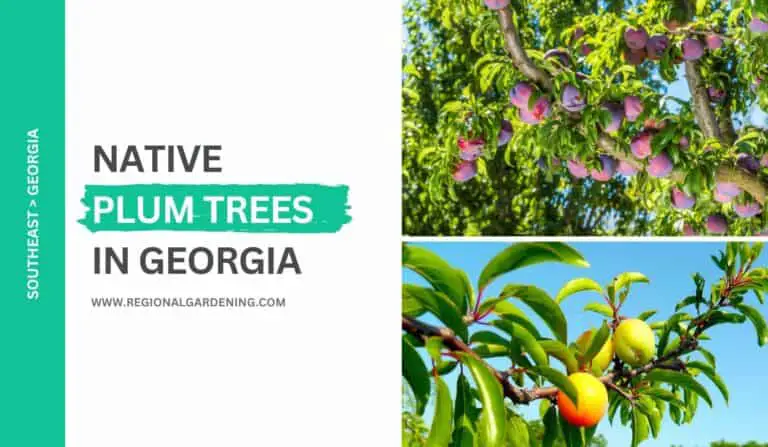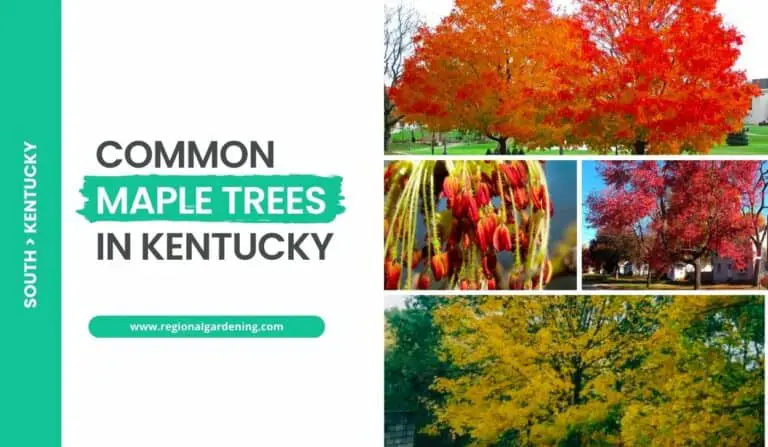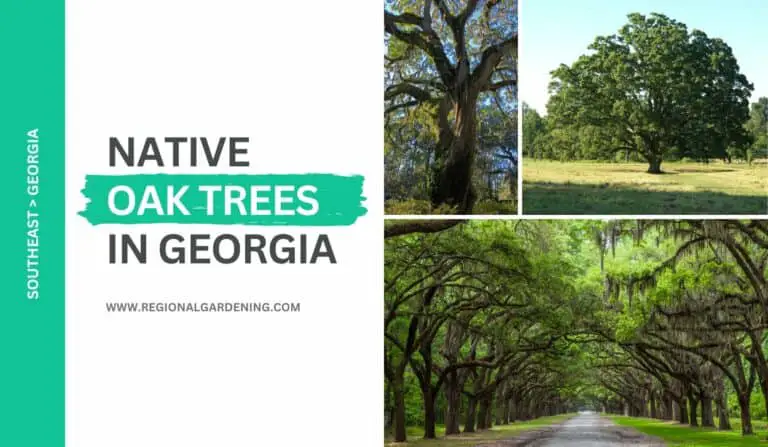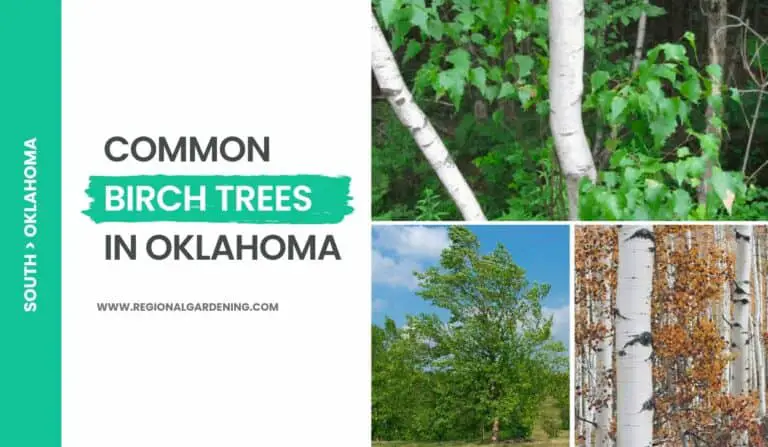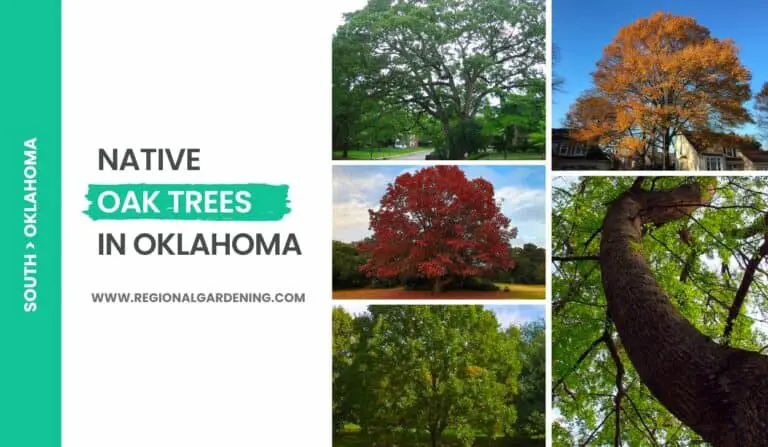5 Native Hickory Trees In Oklahoma (Photos & Identification)
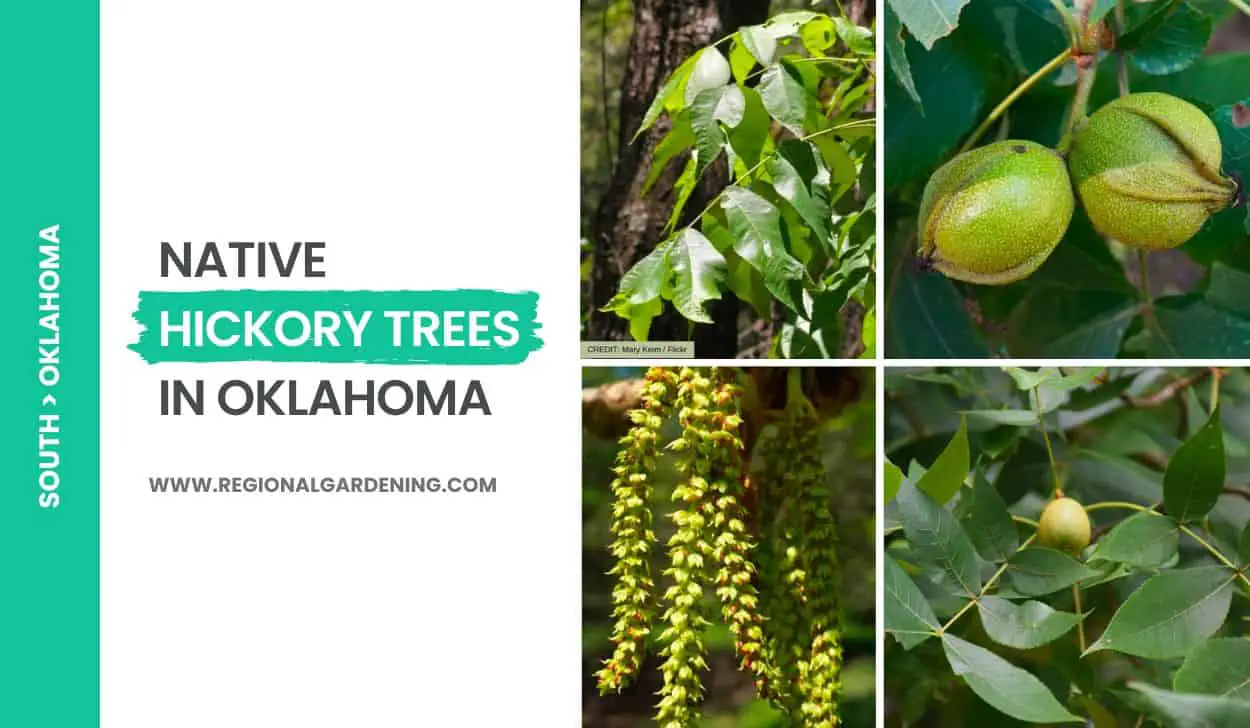
Hickory trees in Oklahoma are a magnificent sight, their regal presence gracing the landscape in a way that enthralls everyone who sees them. These magnificent trees shade and protect countless creatures with their tall, strong trunks and wide canopies.
Hickory trees are prized for more than just their beauty; they also have a wide range of useful applications. Their delicious nuts are a prized addition to many culinary delights, and their strong, dense wood has been used in the construction of furniture, cabinets, and even musical instruments.
Explore the magical realm of hickory trees in Oklahoma in this article.
1. Bitternut Hickory
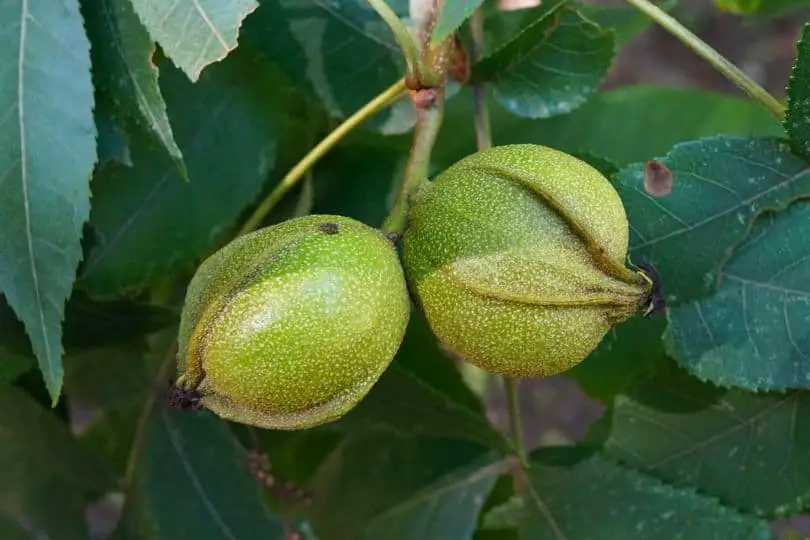
- Scientific Name: Carya cordiformis [Wang.] K. Koch.
- Common Name(s): Bitternut Hickory, Pignut Hickory
- Mature Height: Can reach up to 100 feet (30 meters)
- Native Region: Eastern part of the United States, including Oklahoma
- Flowers: The tree produces both male and female flowers on the same tree.
- Fruit: The fruit is about 1 inch long and has a thin husk, while the nut has a thin shell and a very bitter kernel.
- Uses: The wood of the bitternut hickory is hard, strong, and heavy, making it suitable for various purposes like furniture, flooring, and tool handles.
Bitternut hickory, also known as pignut hickory, grows to be a tall and slender tree with a broadly pyramidal crown. It has a diameter of 2 to 3 feet and a height of up to 100 feet. This tree is mostly found in eastern Oklahoma on moist, rich soils, but it is not particularly common.
Bitternut hickory bark is granite-gray with a little yellow hue. It is smoother than most hickories and has thin, plate-like scales. The compact, scurfy, and bright yellow winter buds distinguish it from other hickory species.
Bitternut hickory leaves are alternating and complex, measuring 6 to 10 inches in length. In comparison to other hickories, they have 5 to 9 smaller and more slender leaflets. On the same tree, the bitternut hickory produces both male and female flowers.
The bitternut hickory fruit is about 1 inch long and has a thin husk. The nut itself is frequently thin-shelled and brittle, with a bitter-tasting kernel.
Bitternut hickory wood is robust, strong, and hefty, with a reddish-brown color. As a result, it is appropriate for a variety of applications such as furniture, flooring, and tool handles. It is sometimes known as “red hickory” because of its color. Although it is regarded as inferior to other hickory species, it is nonetheless utilized for similar reasons.
Bitternut hickory can be planted in moist, rich soils in Oklahoma settings. It prefers full light and necessitates regular watering, especially during dry spells. Pruning is recommended to keep its shape and overall health. It should be noted, however, that the bitternut hickory is not a common tree in Oklahoma gardens, and its quantity is limited.
2. Black Hickory
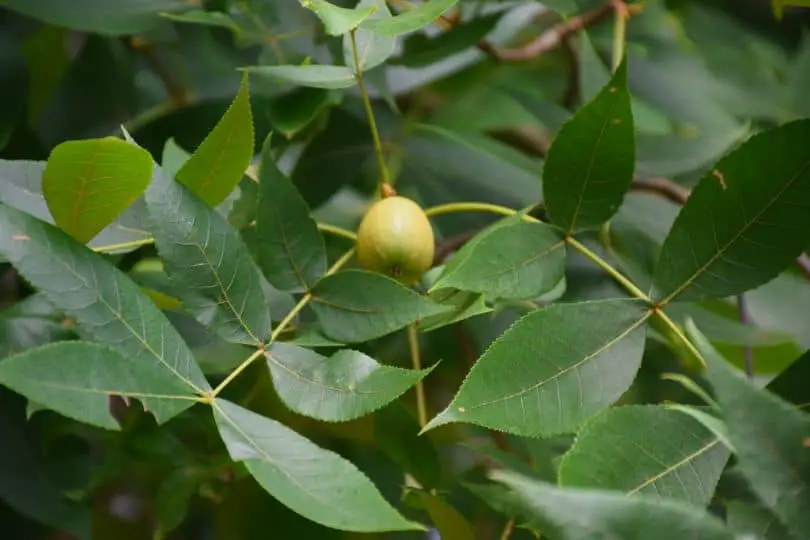
- Scientific Name: Carya texana Buckl.
- Common Name(s): Black Hickory
- Mature Height: 60 to 75 feet (18 to 23 meters)
- Native Region: Ozark region, Arkansas, Oklahoma
- Flowers: Similar to other hickories
- Fruit: Obovoid, with a husk one-twelfth to one-sixth inch thick, splitting to the middle or nearly to the base. The nut is nearly obovoid to oblong rounded at the ends, compressed, and slightly four-angled with a shell one-sixth to one-fifth inch thick.
- Uses: The wood is primarily used for fuel.
The most prevalent species of hickory in the Ozark region is black hickory, scientifically known as Carya texana Buckl. This tree grows on rocky hillsides or sandy uplands and can reach a mature height of 60 to 75 feet (18 to 23 meters) and a trunk diameter of 2 feet. It is simple to identify thanks to its oblong fruit and dusty brown hairs on young leaves and branches.
Black Hickory bark is dark gray or practically black, deeply split into rough ridges or irregularly fissured with thin scales. Winter buds are ovoid and coated in rusty hairs and silvery scales.
The leaves are 8 to 12 inches long, contain 5 to 7 (typically 7) leaflets, and slender rusty-hairy leafstalks. The leaves are dark green and shiny on top, but considerably paler on the undersides. Black Hickory flowers are similar to those of other hickory species.
The Black Hickory tree’s fruit is oblong, with a husk that is one-twelfth to one-sixth inch thick and splits to the middle or nearly to the root.
The nut is approximately rectangular to oblong in shape, with rounded ends and a slightly four-angled shell thickness of one-sixth to one-fifth inch. The seed is sweet and tasty.
The wood of the Black Hickory is hard and brittle and is mostly used for fuel. There is also a variant of Black Hickory known as Carya texana var. Little, which is native to eastern Oklahoma and is distinguished by its flat-topped fruit.
3. Pignut Hickory
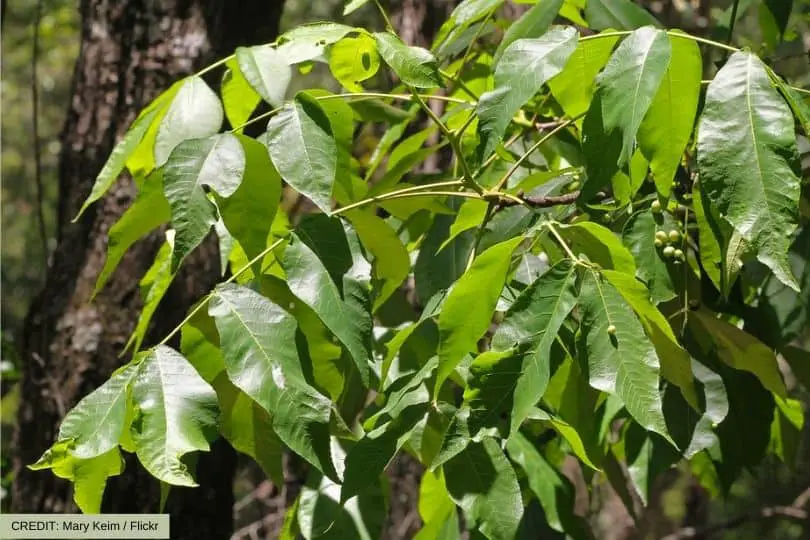
- Scientific Name: Carya glabra
- Common Name(s): Pignut Hickory
- Mature Height: 60-80 feet (18-24 meters)
- Native Region: Eastern and Central United States
- Flowers: No flowers
- Fruit: Small, pear-shaped nuts
- Uses: Pignut hickory wood is used for furniture, tool handles, and flooring. The nuts are edible and often used in cooking or as wildlife food.
Pignut Hickory, scientifically known as Carya glabra, is a medium to large-sized tree typically growing to a height of 60-80 feet (18-24 meters). It is native to the eastern and central regions of the United States, including Oklahoma.
This deciduous tree is characterized by its light gray bark that develops deep furrows with age. Pignut hickory has a rounded or oval-shaped crown and attractive, dark green compound leaves.
Being a native tree, Pignut Hickory is well adapted to the Oklahoma climate and can thrive in a variety of soil types, from sandy to clayey. It prefers well-drained soils and is often found in upland forests or rocky slopes. While it can tolerate some shade, Pignut Hickory prefers full sun exposure to achieve optimal growth.
Pignut hickory trees do not produce showy flowers. Instead, they produce small, pear-shaped nuts that are surrounded by a thick husk. These nuts are edible and provide a valuable food source for wildlife, such as squirrels and birds. They can also be utilized by humans for cooking or baking purposes.
When planting Pignut Hickory in an Oklahoma landscape, it is important to provide adequate space for the tree to grow and develop its canopy. Regular watering is necessary during the establishment period, but once established, the tree is relatively drought-tolerant.
Mulching around the base of the tree helps retain moisture and control weeds. Pruning may be necessary to maintain a desirable shape and remove any dead or damaged branches.
In addition to its natural beauty, Pignut Hickory has practical uses. The wood of this tree is strong and durable, making it highly suitable for furniture, tool handles, and flooring.
Its nuts are also a valuable food source, both for wildlife and as an ingredient in various recipes. Whether planted for its aesthetic appeal or its practical uses, Pignut Hickory is a versatile tree that can enhance the landscape of Oklahoma.
4. Big Shellbark Hickory
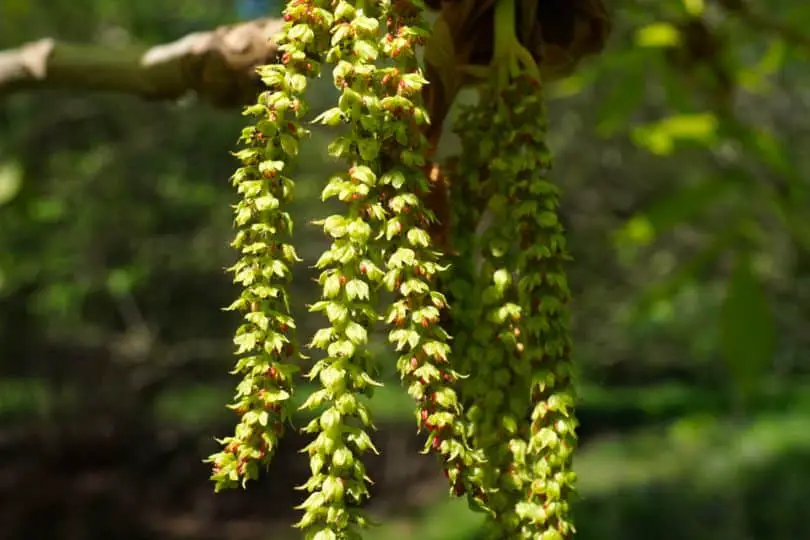
- Scientific Name: Carya laciniosa Michx.
- Common Name(s): King Nut Hickory, Big Shell-Bark Hickory
- Mature Height: Over 100 feet (30 meters)
- Native Region: Eastern part of the United States, including Oklahoma
- Flowers: No flowers
- Fruit: Large, nearly globular nuts with a woody husk
- Uses: The wood is valued for its strength and flexibility and is used for flooring, furniture, and tool handles.
The King Nut Hickory, also known as Big Shell-Bark Hickory, is a huge tree with a slender trunk that can reach heights of over 100 feet. It is most commonly found in the lush bottomland woods of eastern Oklahoma, especially on soil that is inundated for part of the year.
Because of its similar look, this species is frequently confused with scaly bark hickory, however, the King Nut Hickory is bigger. It is distinguished by its hairy, orange-colored branchlets, thick bony nutshell, and increased number of leaflets.
King Nut Hickory bark is light gray and can be 1 to 2 inches thick, separating into plates up to 4 feet long. It has been affixed to the trunk for many years.
The tree produces huge winter buds that can grow to be an inch long and two-thirds of an inch wide. The leaves are complex and can range in length from 15 to 22 inches, with 5 to 9 leaflets. During the winter, the petioles are frequently still attached to the branches.
The fruit of the King Nut Hickory grows alone or in pairs. It is enormous, almost spherical, and slightly flattened at the apex. When mature, the woody husk that surrounds the nut is about a quarter inch thick and brown. The nut measures 2 to 2 12 inches long, 1 12 inch wide, and flattened, with a bony shell approximately a quarter inch thick.
King Nut Hickory wood is dark brown, exceedingly hard, and close-grained. It features a sliver of white sapwood. Because of its strength and flexibility, it is great for flooring, furniture, and tool handles.
The King Nut Hickory can be cultivated in landscapes with rich, well-drained soil in Oklahoma. It enjoys full light but may tolerate some shade. To promote optimal growth, it is critical to offer frequent irrigation, especially during dry months.
Pruning may be required to keep its shape and to remove any dead or damaged branches. Mulching at the base of the tree may also help to retain moisture and discourage weed growth.
The majestic King Nut Hickory tree adds beauty and flair to any garden or environment. Its grandeur and magnificent trunk make it a focal point, while the nuts and foliage add visual appeal.
Furthermore, the wood’s durability and flexibility make it a great resource for a variety of woodworking applications.
5. Mockernut Hickory
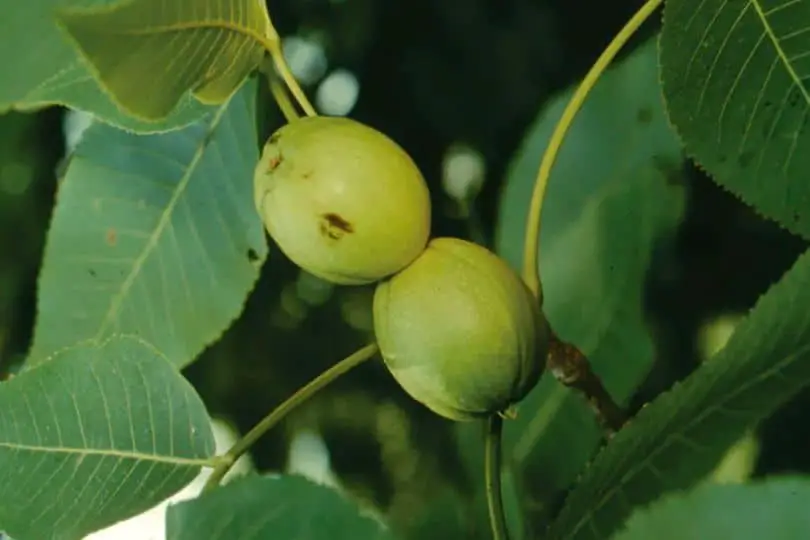
- Scientific Name: Carya tomentosa Nutt.
- Common Name(s): Whiteheart, White Hickory, Mockernut Hickory, Big-Bud Hickory
- Mature Height: 60 feet (18 meters)
- Native Region: Eastern part of the State
- Flowers: Male flowers in three-branched catkins, female flowers in clusters of 2 to 5
- Fruit: Oval or nearly round with a thick, strong-scented husk that splits nearly to the base when ripe. The nut is light brown, sometimes ridged, with a thick shell and small, sweet kernel.
- Uses: The wood is used for vehicle parts and handles. It is also a desirable tree for both forest and shade. The nuts can be harvested for their sweet kernels.
The Whiteheart or White Hickory, also known as the Mockernut Hickory or Big-Bud Hickory, is a tall tree with a diameter of 1 to 2 feet and an average height of 60 feet (18 meters). It is most common in eastern Oklahoma, particularly on well-drained soils. White hickory bark is dark gray, rigid, and furrowed, with a cross-furrowed or netted look. Winter buds are big, spherical, or egg-shaped, and covered in downy, firm scales. The most recent shoots are short and sturdy, with a downy growth pattern.
The White Hickory leaves are huge, fragrant, and hairy. They have 7 to 9 obovate to oblong, pointed leaflets that turn a lovely yellow in the fall.
The White Hickory, like other hickory trees, has both male and female blooms on the same tree. Male flowers grow in three-branched catkins, whereas female flowers grow in 2 to 5 clusters.
The blossoms turn into fruit after being fertilized. When ripe, the White Hickory fruit is oval or almost circular, with a thick, strongly perfumed husk that splits almost to the base. The nut within might vary in appearance, but it is often ridged, light brown, and has a thick shell containing a small, delicious kernel.
White hickory wood is highly prized for its strength and hardness. Except for the comparably little, dark-brown heartwood that gives the tree its name, it is heavy, hard, and white. The wood is often used for automobile parts and handles, and it also works well as fuel.
The White Hickory is a valuable tree in Oklahoma for both forest planting and shade. It grows well in well-drained soils and can withstand a wide range of environmental conditions. It is critical to provide appropriate watering during dry months for White Hickory in Oklahoma settings, especially in the early years of growth.
Regular pruning is also advised to keep the tree in form and to remove any dead or diseased limbs.
Additionally, White Hickory nuts can be collected for their sweet kernels. They can be eaten raw or roasted and lend a great flavor to a variety of meals. The White Hickory is not only a beautiful and useful tree, but it also serves as an important food source for wildlife in Oklahoma gardens.
6. Pecan Hickory
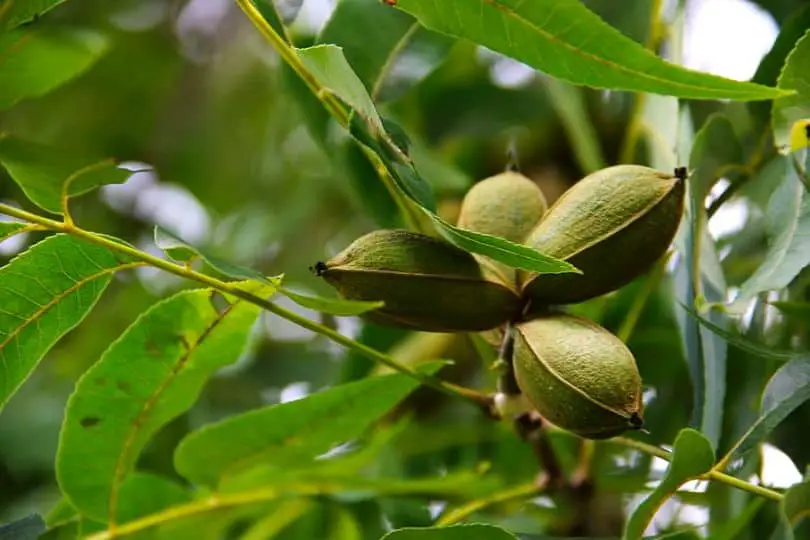
- Scientific Name: Carya illinoisensis
- Common Name(s): Pecan
- Mature Height: Over 100 feet (30 meters)
- Native Region: South and east of diagonal line in Oklahoma
- Flowers: Tassel-like flowers that hang 2-3 inches long
- Fruit: Nut, 4-winged or angled, pointed, 1-2 inches long, and 1/2 to 1 inch in diameter
- Uses: Shade tree, nut production, wood for handles, vehicles, and fuel
The pecan tree, Carya illinoensis, is a natural tree found in Oklahoma south and east of a diagonal line made from the northeast to the southwest corner. It is also found north of this border in Garfield and Grant Counties. It is a superb shade tree and is frequently planted for its appealing appearance as well as its many nuts.
When growing in wide regions, the pecan tree is the tallest of the hickories, reaching heights of over 100 feet and having a large rounded top with a symmetrical appearance. The tree’s bark is rough, hard, and tight, with a tendency to split into scales. The bark on the limbs begins smooth but later scales or separates as it ages.
The leaves of the pecan tree are similar to those of hickories and black walnuts. They have 9 to 17 leaflets that are oblong, toothed, and long-pointed and are 4 to 8 inches long and 2 inches wide.
Tassel-like blossoms appear on the pecan tree in early spring, dangling 2 to 3 inches long. These blooms mature into nuts that are four-winged or angled, pointy, and 1 to 2 inches long and 1/2 to 1 inch in diameter. When the nut ripens in the fall, it is encased in a husk that splits along its grooved seams.
Pecan nuts have been substantially improved through selection and cultivation and are now available in big quantities on the market.
The pecan tree’s wood is recognized for being robust, tough, hefty, and hard. It is occasionally utilized in the manufacture of handles, and car parts, and as a fuel source.
It is critical to offer well-drained soil and plenty of sunlight when planting pecan trees in Oklahoma. Regular deep watering will help the trees, especially during dry years. Planting many trees for cross-pollination is recommended to increase nut production.
To preserve a balanced shape and remove any dead or diseased wood, pruning should be done during the dormant season.
7. Nutmeg Hickory
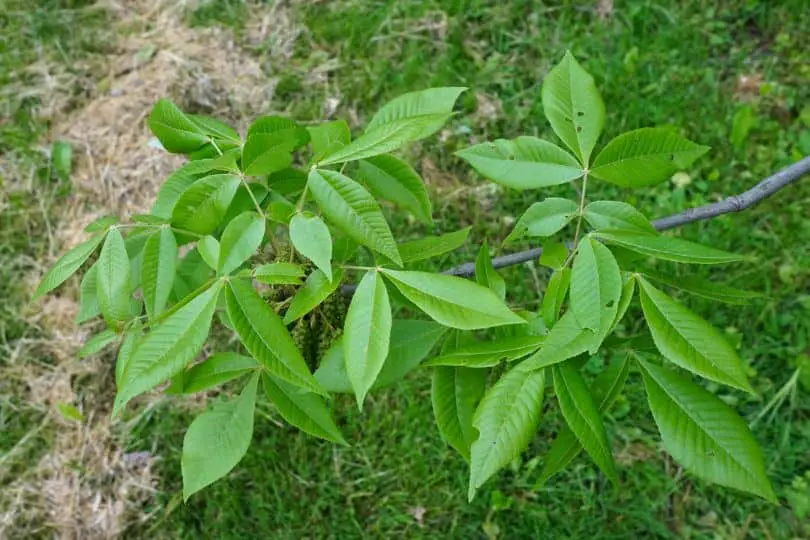
- Scientific Name: Carya myristicaeformis Nutt.
- Common Name(s): Nutmeg Hickory
- Mature Height: It can reach a height of about 90 feet (27 meters).
- Native Region: The Nutmeg Hickory is native to the flood plains and swamp bottoms of the Red River, and it is found in Oklahoma, specifically in western Choctaw County.
- Flowers: No flowers.
- Uses: The wood of the Nutmeg Hickory is used for manufactured parts where hickory wood is desirable.
The Nutmeg Hickory, scientifically known as Carya myristicaeformis Nutt., is a tree that may grow to be 90 feet tall and is usually found in the flood plains and marsh bottoms of Oklahoma’s Red River. It has a limited range and has been found as far west as western Choctaw County. Locally, it is known as the “blasted pecan.”
The Nutmeg Hickory’s bark is dark brown, tinted with red, and half to three-quarters of an inch thick, with small fissures. The bark’s ridges divide into uneven, close, dark, reddish-brown scales. The leaves are complex and range in length from 8 inches to over a foot, with 5 to 9 short-stalked or nearly sessile leaflets. The leaflets are dark green on top and silvery-white glossy on the underside. The hairy midrib is one of this species’ distinctive features.
The Nutmeg Hickory fruit is distinct, usually single, and approximately 1/2 inch long. It is covered in yellow-brown scurfy hairs and has four ridges on the base. The husk is thin and splits almost to the bottom, revealing the ellipsoidal nut.
The nut contains gray lines and patches on its reddish-brown surface that resembles nutmeg, as well as a thick and extremely hard bony shell. The seed within is delicious.
Nutmeg Hickory wood is hard, heavy, exceedingly robust, and close-grained. It is light brown and has a thick covering of sapwood with 80 to 90 growth rings. This makes it appropriate for use in manufactured items that require hickory wood. Although the Nutmeg Hickory is considered a rare hickory in North America, it is very common in Oklahoma’s Red River bottoms.
The Nutmeg Hickory may be a lovely addition to Oklahoma gardens, bringing height and shade to the environment. Its complex leaves and unique bark add visual interest to the plant.
It is crucial to note, however, that the Nutmeg Hickory is often found in rich soil on the edges of streams and swamps, where it thrives in damp circumstances. It is best adapted to areas with abundant water availability and may struggle in the state’s drier, more arid sections.
Furthermore, when planting near structures or other plants, its great size and spreading root system should be considered. Despite its importance as a landscaping tree, the Nutmeg Hickory is largely appreciated for its hard, robust wood, which may be used in a variety of manufacturing applications where hickory is desired.
Similar Articles
- Native Pine Trees In Oklahoma
- Native Maple Trees In Oklahoma
- Native Elm Trees In Oklahoma
- Common Palm Trees In Oklahoma
- Native Oak Trees In Oklahoma
- Native Cedar Trees In Oklahoma
- Common Cherry Trees In Oklahoma
- Native Ash Trees In Oklahoma
- Common Birch Trees In Oklahoma
- Native Cypress Trees In Oklahoma
Native Hickory Trees In Oklahoma – Sources
The Regional Gardening team makes sure that the information in our articles is accurate by only using sources that are known to be trustworthy. Some of these sources are peer-reviewed journals from government agencies, well-known universities, and scientific research organizations.
- Forest Tree Species, Oklahoma State University Extension
- Oklahoma Trees for Gardening Resource, Oklahoma State University Extension
- Oklahoma Native Trees by County, Oklahoma Forestry Services
- Native Plant Guide, Oklahoma County Conservation District
- Plants, Seeds & Landscapes, Oklahoma Native Plant Society
- Plant Selections for Oklahoma, Oklahoma State University Extension


